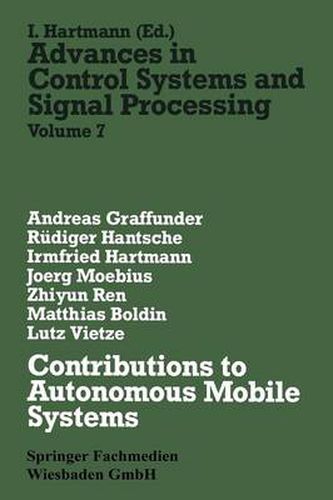Readings Newsletter
Become a Readings Member to make your shopping experience even easier.
Sign in or sign up for free!
You’re not far away from qualifying for FREE standard shipping within Australia
You’ve qualified for FREE standard shipping within Australia
The cart is loading…






This title is printed to order. This book may have been self-published. If so, we cannot guarantee the quality of the content. In the main most books will have gone through the editing process however some may not. We therefore suggest that you be aware of this before ordering this book. If in doubt check either the author or publisher’s details as we are unable to accept any returns unless they are faulty. Please contact us if you have any questions.
Autonomous mobile systems (AMS) are systems capable of some mobility and equipped with advanced sensor devices in order to flexibly respond to changing environmental situations, thus achieving some degree of autonomy. The purpose of this book is to contribute to some essential topics in this broad research area related to sensing and control, but not to present a complete design of an AMS. Subjects conceming knowledge based control and decision, such as moving around obstacles, task planning and diagnosis are left for future publications in this series. Research in the area of AMS has grown rapidly during the last decade, see e.g. [WAXMAN et al. 87], [DICKMANNS , ZAPP 87]. The requirements of an AMS strongly depends on the desired tasks the system should execute, its operational environment and the expected speed of the AMS. For instance, road vehicles obtain velocities of 10 m/s and more, therefore the processing of sensor data such as video image sequences has to be very fast and simple, while indoor mobile robots deal with shorter distances and lower speeds, thus more sophistcated techniques are applicable and -as is done in our approach- additional sensors can be integrated to allow for multi sensor processing.
$9.00 standard shipping within Australia
FREE standard shipping within Australia for orders over $100.00
Express & International shipping calculated at checkout
This title is printed to order. This book may have been self-published. If so, we cannot guarantee the quality of the content. In the main most books will have gone through the editing process however some may not. We therefore suggest that you be aware of this before ordering this book. If in doubt check either the author or publisher’s details as we are unable to accept any returns unless they are faulty. Please contact us if you have any questions.
Autonomous mobile systems (AMS) are systems capable of some mobility and equipped with advanced sensor devices in order to flexibly respond to changing environmental situations, thus achieving some degree of autonomy. The purpose of this book is to contribute to some essential topics in this broad research area related to sensing and control, but not to present a complete design of an AMS. Subjects conceming knowledge based control and decision, such as moving around obstacles, task planning and diagnosis are left for future publications in this series. Research in the area of AMS has grown rapidly during the last decade, see e.g. [WAXMAN et al. 87], [DICKMANNS , ZAPP 87]. The requirements of an AMS strongly depends on the desired tasks the system should execute, its operational environment and the expected speed of the AMS. For instance, road vehicles obtain velocities of 10 m/s and more, therefore the processing of sensor data such as video image sequences has to be very fast and simple, while indoor mobile robots deal with shorter distances and lower speeds, thus more sophistcated techniques are applicable and -as is done in our approach- additional sensors can be integrated to allow for multi sensor processing.